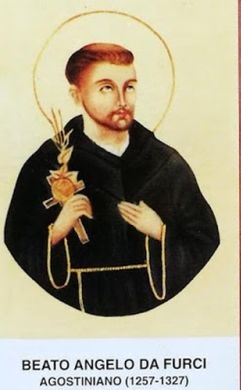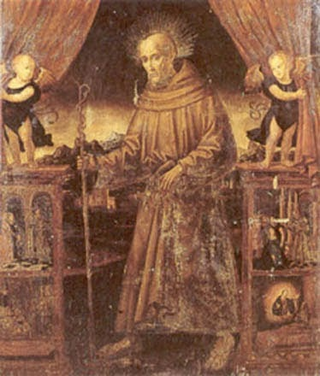Ugolino is an Italian masculine given name that is a diminutive form of Ugo. It may also refer to:
Giovanni Battista Righi was an Italian Roman Catholic priest and a professed member from the Order of Friars Minor. He was known for ascetic life and for his preaching and healing abilities.

Jakub Strzemię was a Polish Roman Catholic archbishop and a professed member of the Order of Friars Minor. He served as the Archbishop of Halicz from 1392 until his death when the archdiocese was incorporated into that of the Archdiocese of Lviv.

Angelo da Furci was an Italian Catholic priest and a professed member of the Order of Saint Augustine. He was a friend and student of Giles of Rome and served as Prior Provincial of the Abruzzi branch of the congregation.

Baldassare Ravaschieri was an Italian Roman Catholic priest and a professed member of the Order of Friars Minor of the strict observance. Ravaschieri served as a noted preacher and confessor and befriended as contemporaries Blessed Bernardine of Feltre and architect Giovanni Antonio Amadeo.
Mattia Ciccarelli, in religious Cristina, was an Italian nun from the Order of Saint Augustine noted for her ecstasies and the reception of the stigmata. The religious was also known for her generous donations to the poor of the Abruzzo region despite being in the monastery.

Agostina Camozzi - in religious Cristina - was an Italian Roman Catholic professed religious from the Order of Saint Augustine. Camozzi led a dissolute life as a widow and a soldier's mistress before she became a nun and adopted a life of total repentance.

Francesco Lippi was an Italian Roman Catholic professed religious from the Carmelites. He lived his life as a soldier before suffering the loss of sight at which point his healing led him down the path of repentance and into the Carmelites.

Elena Duglioli was an Italian Roman Catholic aristocrat from Bologna noted for her devotion to Christian life and social teachings. Duglioli wanted to become a nun for the Poor Clares but instead married in order to please her parents. Duglioli is best known for commissioning a chapel with an image of Saint Cecilia to whom she was devoted.

Antonio Patrizi was an Italian Roman Catholic priest and a professed member of the Order of Saint Augustine. Patrizi joined the order in Lecceto and lived as a hermit prior to his sudden death while visiting his friend at another convent.

Guala de Roniis was an Italian catholic priest and a professed member of the Order of Preachers as one of Dominic of Osma's earliest disciples. De Roniis was born as a noble and was appointed as the Bishop of Brescia after Dominic's death though also served as a popular papal legate that earned him popular and papal support. He resigned from his episcopal see to dedicate the remainder of his life to peaceful solitude though his reputation for personal holiness prompted countless people to seek him out for his counsel.

Benincasa da Montepulciano was an Italian Roman Catholic professed religious from the Servite Order. He lived as a hermit in Siena his entire life since he joined the order as a teenager and dedicated himself to a quiet life of servitude to God in contemplation despite still receiving visitors and orders from his superiors.
Elena Valentinis was an Italian Roman Catholic professed religious from the tertiaries of the Order of Saint Augustine. Valentinis was born to nobles and married a knight during her adolescence while mothering six children before she was widowed in 1441. She soon became a professed religious and dedicated herself to austerities and a life of complete penance.

Andrea Caccioli was an Italian Roman Catholic priest and a professed member from the Order of Friars Minor. He became the first priest to enter the Franciscans and served as one of the disciples of Francis of Assisi himself - the priest was at his deathbed and attended his canonization. The friar preached across Italian cities such as Rome and Padua as well as in France and he became noted for miracles performed during his lifetime.

Gregorio Celli was an Italian priest of the Roman Catholic Church and a professed member of the Order of Saint Augustine. Celli lived with the latter order in Rimini until he decided to spend the remainder of his life in deep contemplation and so moved to the region's hills where he dwelled in a cave near the Franciscans stationed there. It is claimed he was expelled from his order and became a Franciscan though there is no evidence to support this claim.

Angelo of Foligno - born Angelo Conti - was an Italian Catholic priest and a professed friar of the Order of Saint Augustine. Conti was part of the order of John the Good though became a mainstream Augustinian in 1256 after the Grand Union of the order. He was a close friend of both Saint Nicholas of Tolentino and Blessed Ugolino da Gualdo Cattaneo.
Blessed Hartmann of Brixen was a German prelate of the Catholic Church, who served as the Bishop of Brixen from his appointment in 1140 until his death. Hartmann served alongside the Order of Saint Augustine - who oversaw his education - and he managed certain aspects of their order despite not being part of that congregation. He also supported Pope Alexander III during his struggle with Frederick Barbarossa and also earned the favor of the latter despite Hartmann's views of the schism.

Bartolomeo Fanti was an Italian Roman Catholic priest from the Carmelite order in Mantua. Fanti served as the spiritual director and rector of a religious movement in his hometown and oversaw the establishment of their rule and statutes while himself serving as a novice master for his own order where he became known for being an effective preacher.

Giuliana Puricelli was an Italian Roman Catholic professed religious from the Order of Saint Augustine. Puricelli left her home after her father wanted to have her married and so fled to a hermitage where she placed herself under the spiritual direction of Caterina Moriggi. The two became close friends and their hermitage grew over the following decades. Her reputation was noted throughout the area for her contemplation and penitential practices as well as for her desire to live a cloistered life meditating on God.

Gerardo Cagnoli was an Italian Roman Catholic and professed religious from the Order of Friars Minor. He embarked on a long pilgrimage south where he passed through Rome and Naples before settling in Trapani and then on the slopes of Mount Etna for a long hermitage. He later entered the Franciscans and served in two of their Sicilian convents where he was known for having caused miracles in addition to his humble and simple childlike nature which people believed was one of the signs of his holiness.
















